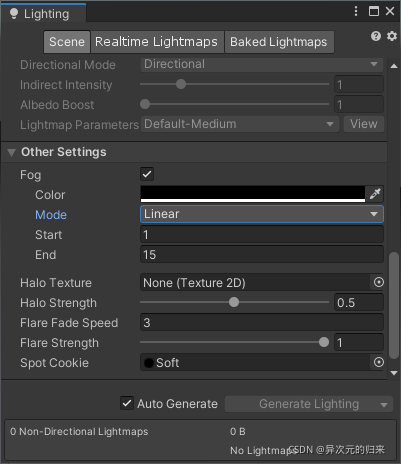Unity中的雾效
Unity原生是支持雾效的,可以通过Window/Rendering/Lighting Settings设置:

Unity支持3种模式的雾效,Linear,Exponential,Exponential Squared。
Linear模式对应的雾效系数公式如下:
f
=
E
?
c
E
?
S
f = \dfrac{E - c}{E - S}
f=E?SE?c?
其中,E为雾效的结束距离,S为开始距离,c为当前点的雾效坐标。
Exponential模式对应的雾效系数公式如下:
f
=
1
2
c
d
f = \dfrac{1}{2^{cd}}
f=2cd1?
其中,d为雾效的密度系数。
Exponential Squared模式对应的雾效系数公式如下:
f
=
1
2
(
c
d
)
2
f = \dfrac{1}{2^{(cd)^2}}
f=2(cd)21?
在前向渲染中,我们可以根据雾效系数的值,对雾效颜色和计算出的pixel color进行插值,得到最终的颜色:
float4 ApplyFog (float4 color, Interpolators i) {
float viewDistance = length(_WorldSpaceCameraPos - i.worldPos.xyz);
#if FOG_DEPTH
viewDistance = UNITY_Z_0_FAR_FROM_CLIPSPACE(i.worldPos.w);
#endif
UNITY_CALC_FOG_FACTOR_RAW(viewDistance);
float3 fogColor = 0;
#if defined(FORWARD_BASE_PASS)
fogColor = unity_FogColor.rgb;
#endif
color.rgb = lerp(fogColor, color.rgb, saturate(unityFogFactor));
return color;
}
有两种方式可以计算当前点的雾效坐标,一是计算当前点到相机位置的距离,二是计算当前点在相机空间中的深度z,Unity提供了UNITY_Z_0_FAR_FROM_CLIPSPACE这个API进行计算,它接受一个齐次剪裁空间下的z作为参数:
#if defined(UNITY_REVERSED_Z)
#if UNITY_REVERSED_Z == 1
//D3d with reversed Z => z clip range is [near, 0] -> remapping to [0, far]
//max is required to protect ourselves from near plane not being correct/meaningfull in case of oblique matrices.
#define UNITY_Z_0_FAR_FROM_CLIPSPACE(coord) max(((1.0-(coord)/_ProjectionParams.y)*_ProjectionParams.z),0)
#else
//GL with reversed z => z clip range is [near, -far] -> should remap in theory but dont do it in practice to save some perf (range is close enough)
#define UNITY_Z_0_FAR_FROM_CLIPSPACE(coord) max(-(coord), 0)
#endif
#elif UNITY_UV_STARTS_AT_TOP
//D3d without reversed z => z clip range is [0, far] -> nothing to do
#define UNITY_Z_0_FAR_FROM_CLIPSPACE(coord) (coord)
#else
//Opengl => z clip range is [-near, far] -> should remap in theory but dont do it in practice to save some perf (range is close enough)
#define UNITY_Z_0_FAR_FROM_CLIPSPACE(coord) (coord)
#endif
该函数其实就是根据API的不同,是否启用REVERSE_Z,将clip空间下的z归一化到[0, f]范围内。这里的f为远裁剪面,_ProjectionParams是一个4维向量,它的y分量表示近剪裁面n,z分量表示远剪裁面f。
得到雾效坐标之后,可以代入Unity提供的APIUNITY_CALC_FOG_FACTOR_RAW计算雾效的系数:
#if defined(FOG_LINEAR)
// factor = (end-z)/(end-start) = z * (-1/(end-start)) + (end/(end-start))
#define UNITY_CALC_FOG_FACTOR_RAW(coord) float unityFogFactor = (coord) * unity_FogParams.z + unity_FogParams.w
#elif defined(FOG_EXP)
// factor = exp(-density*z)
#define UNITY_CALC_FOG_FACTOR_RAW(coord) float unityFogFactor = unity_FogParams.y * (coord); unityFogFactor = exp2(-unityFogFactor)
#elif defined(FOG_EXP2)
// factor = exp(-(density*z)^2)
#define UNITY_CALC_FOG_FACTOR_RAW(coord) float unityFogFactor = unity_FogParams.x * (coord); unityFogFactor = exp2(-unityFogFactor*unityFogFactor)
#else
#define UNITY_CALC_FOG_FACTOR_RAW(coord) float unityFogFactor = 0.0
#endif
unity_FogParams是一个4维向量,保存了Light Setting中的fog相关参数:
// x = density / sqrt(ln(2)), useful for Exp2 mode
// y = density / ln(2), useful for Exp mode
// z = -1/(end-start), useful for Linear mode
// w = end/(end-start), useful for Linear mode
float4 unity_FogParams;
计算出雾效系数之后,需要根据当前是否是forward base pass,来考虑是否叠加雾效的颜色。这是因为当有多个光源时,forward pass会执行多次,而实际上我们只需要叠加一次雾效的颜色即可。
而在延迟渲染路径中,要使用雾效则有点麻烦。由于G-Buffer中保存的是场景的几何信息,并非是经过光照计算后的信息,因此无法在geometry pass阶段使用类似前向渲染路径的策略。我们需要通过后处理,将最终输出的颜色和雾效进行叠加计算。后处理使用的shader参考如下:
Shader "Custom/Deferred Fog" {
Properties {
_MainTex ("Source", 2D) = "white" {}
}
SubShader {
Cull Off
ZTest Always
ZWrite Off
Pass {
CGPROGRAM
#pragma vertex VertexProgram
#pragma fragment FragmentProgram
#pragma multi_compile_fog
#define FOG_DISTANCE
// #define FOG_SKYBOX
#include "UnityCG.cginc"
sampler2D _MainTex, _CameraDepthTexture;
float3 _FrustumCorners[4];
struct VertexData {
float4 vertex : POSITION;
float2 uv : TEXCOORD0;
};
struct Interpolators {
float4 pos : SV_POSITION;
float2 uv : TEXCOORD0;
#if defined(FOG_DISTANCE)
float3 ray : TEXCOORD1;
#endif
};
Interpolators VertexProgram (VertexData v) {
Interpolators i;
i.pos = UnityObjectToClipPos(v.vertex);
i.uv = v.uv;
#if defined(FOG_DISTANCE)
i.ray = _FrustumCorners[v.uv.x + 2 * v.uv.y];
#endif
return i;
}
float4 FragmentProgram (Interpolators i) : SV_Target {
float depth = SAMPLE_DEPTH_TEXTURE(_CameraDepthTexture, i.uv);
depth = Linear01Depth(depth);
float viewDistance =
depth * _ProjectionParams.z - _ProjectionParams.y;
#if defined(FOG_DISTANCE)
viewDistance = length(i.ray * depth);
#endif
UNITY_CALC_FOG_FACTOR_RAW(viewDistance);
unityFogFactor = saturate(unityFogFactor);
#if !defined(FOG_SKYBOX)
if (depth > 0.9999) {
unityFogFactor = 1;
}
#endif
#if !defined(FOG_LINEAR) && !defined(FOG_EXP) && !defined(FOG_EXP2)
unityFogFactor = 1;
#endif
float3 sourceColor = tex2D(_MainTex, i.uv).rgb;
float3 foggedColor =
lerp(unity_FogColor.rgb, sourceColor, unityFogFactor);
return float4(foggedColor, 1);
}
ENDCG
}
}
}
实现思路与前向渲染类似,只是后处理时,我们的顶点信息实际上只有quad的4个顶点,并不足以计算出当前pixel到相机位置的距离。因此这里还借用了_FrustumCorners参数,它传递的是相机的视锥体信息,通过quad的4个顶点插值出quad的每个pixel到相机位置的射线,乘以当前pixel在相机空间的01深度,就可以算出当前pixel对应的物体到相机位置的距离。另外有一点值得一提的是,为了避免后处理时把雾效颜色混合进skybox,可以人为设定,当相机空间的深度接近远剪裁面时,忽略掉雾效的影响。
Reference
[1] Fog